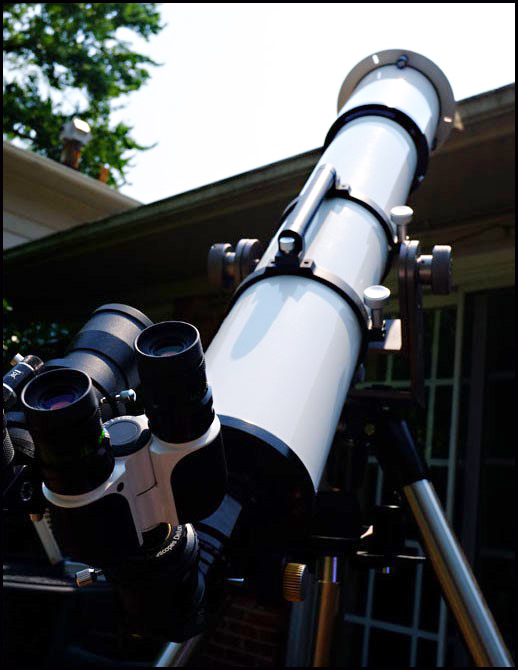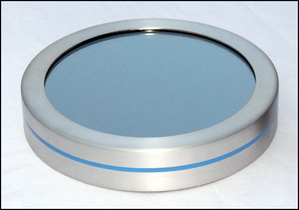Baader ASTF White Light Solar Filter
by: William A. Paolini
White light solar viewing is a very rewarding pursuit that allows one to utilize their night time astronomical equipment with minimal additional investment. I have usually focused my solar observing using hydrogen alpha, but once I saw all the details a good white light solar setup could provide I then became hooked and now enjoy white light much more than hydrogen alpha solar viewing. My standard setup for white light solar viewing has been a Takahashi TSA-102 APO with binoviewer. Over the objective I use a standard full aperture glass solar filter, the type typically sold by Orion and others. I have heard from others that the solar Mylar film can provide better performance but I have always been skeptical about these claims.
Since I wanted to get a solar filter for my new Lunt 152-ED Apo to up the game in my white light solar observing, I figured this would be a good time to put a standard glass solar filter to the test against the Mylar film types. I chose the Baader ASTF (AstroSolar™ Telescope Filter) line of white light solar filters that use Baader AstroSolar™ safety film mounted stress free in temperature compensated cell. The film itself is marketed as a step up in quality over standard Mylar offerings being ion implanted and metallized with a tough, color-neutral layer on both sides of the film. This process claims being more durable and optically more precise.
The special temperature compensated cell is a feature of the ASTF version of this solar filter (they also have less expensive ASSF and ASBF lines that do not have the temperature compensated cell). This cell is designed to have the same thermal expansion as the AstroSolar™ filter material, allowing the film to stay floating within the aluminum frame of the cell. This temperature compensated cell is supposed to enable the AstroSolar™ filter material to retain excellent optical quality at temperatures between -22°F to +122°F (-30°C to +50°C). In my use of the filter on my Lunt 152 Apo the temperature compensated cell indeed seemed to work as advertised as the safety film retained its general unstressed shape throughout observations and did not show any propensity to become overly stretched or taught.
When I was
reviewing the marketing on this new filter, everything seemed fine but
the one concern I had was with the mounting. Looking at the pictures I
could not imagine that the three rubberized feet would provide a secure
enough hold to keep the filter in place in case there was a strong wind
gust during observing. Luckily the supplied materials with the filter
also supply additional securing straps that offer a secondary level of
protection. But these require affixing a Velcro patch to the dew shield
which I was not fond of doing. But still, I decided to take a chance
as I liked the concept of the temperature compensated cell and also that
the cell provided some additional level of shade for the telescope’s
optical tube. I felt this would be an advantage, as keeping direct
sunlight off the optical tube might help keep internal thermals to a
minimum.
For my setup on the Lunt 152 I used the ASTF-160 as the most appropriate model of the product to fit my dew shield. This would allow me to take advantage of the entire 152mm of aperture of my scope and the three rubberized feet would then clamp on the exterior of the dew shield. Overall, when I received the product, I was very pleased with its general quality — not one part of the product seemed cheap or under engineered. The lens cell itself was robust and rigid and the rubberized feet were similarly robustly engineered. When I attached the feet to the cell I did it so the rubberized surfaces were slightly smaller than the outside diameter of my dew shield. In doing this, it then required some significant force to slip the ASTF onto the Lunt 152’s dew shield. A nice feature of this product is that the rubberized feet are adjustable so they can fit a range of dew shield sizes, and you have multiple slots so the range of sizes works for using either the inside or the outside of the dew shield. In my case, I found the position that fit my dew shield’s outside diameter, then I positioned the rubber feet to a slightly smaller setting so they would strongly grip the dew shield. Overall a very flexible system.
With the
ASTF now securely in place I assessed what its propensity might be to
being blown off by any gust of wind. In my estimation, after tugging
and hitting the lens cell to simulate forces from a gust of wind, I was
pleased to see that the filter would probably stay in place in any wind
condition less than gale force! So the filter presented itself as being
firmly secure with just the rubberized feet. And given the length of
these feet, there was no way to pull at any one side of the cell to make
it come off. So it must be pulled straight for it to come off the dew
shield, making it less likely in my estimation that any wind gust could
remove this filter. Still, the inclusion of the safety straps are a
good additional level of security and I recommend folks still use them
as recommended for complete safety. For myself, since I do not want to
put Velcro patches on my OTA, so I devised an alternative strategy by
cutting a flat rubber sheet into a 1″ne inch wide strip that can be
stretched around the dew shield. With the ASTF supplied Velcro patches
sewn onto that and two additional Velcro patches sewn onto the ends of
the rubber strip so it can be secured tightly like a head band around
the dew shield, this allowed a solution that did not require permanently
affixing Velcro patches on the dew shield. With this, one can simply
tightly secure the rubber strip to any dew shield like a head band, and
then have the ASTF safety straps attach to that. I did not have this
ready for my observational testing so it is not pictured here. But it
is a simple do it yourself addition if one does not want to place the
Velcro patches directly onto the dew shield or telescope OTA for this
second level of protection — you can never be too safe when it comes to
solar observing so always take every precaution possible.
OBSERVING
Solar observing through the 152 Apo using the ASTF exceeded all my expectations. The optical train for my observations included a Baader Zeiss T2 prism diagonal, William Optics binovewers, and a pair of Takahashi 18mm LE eyepieces. The level of additional detail in this setup was astoundingly better compared to the 102 Apo using the standard flat glass solar filter. Details were more abundant and significantly more etched. Granulation was not just but showing as a non-descript grainy surface but revealing the individual granules as nicely defined crisp hark specks peppering the solar surface. Penumbral filaments were individually visible and completely defined, even the v-shape shapes at outer edges. Faculae were bright and distinct near the solar edge, but surprisingly visible on the interior of the solar disk as well, although less distinctly, which was an unexpected surprise. Finally, the image was pleasingly bright and completely neutral in color showing the solar disk as white and not orange or yellow, so I was able to push magnifications without an overly dim view even at 200x and more. Basically it was simply an amazing level of details with the ASTF on the Lunt 152 ED Apo.
Next it was
tine for some comparative experiments with the 102mm Apo now that 152mm
solar observing had proven so successful. For this I set up my TSA-102
with the standard flat glass solar filter popularly available under a
number of brandings.
The pair of 18mm Tak LEs were used in the William Optics Binoviewer with its 1.6x OCA. This yielded in the TSA a magnification of approximately 73x. Not having an ASTF filter sized for the smaller TSA-102, I simply devised a stretch band that securely held two of the ASTF’s rubber feet securely with significant pressure onto the dew shield. Not the best setup for safety, but secure enough restricting my observing to windless days for the evaluation.
Observing first with the glass filter, then with the ASTF, and repeating this process several times I was thoroughly surprised at the difference. I was expecting little difference in the view as I was thinking how could a loose Mylar-type of solar material be better than a hard glass flat filter? Wow, was I ever surprised. First the image was significantly brighter through the ASTF than through the glass filter. Easily there was a two f-stop or greater brightness increase with the ASTF. Individual details of the umbra, penumbra, filaments, granulation, and faculae were all significantly more etched. Granulation was there as a sort of an uneven albedo of the surface giving it a kind of roughness and not very distinct in the glass filter, but in the ASTF it was completely distinct as sharp little well defined and observable specks. Penumbral filaments were only somewhat visible in the glass filter with their radial pattern being only hinted at, while through the ASTF I could see all the filaments individually including their nicely jagged outer edges. It was basically what I would call a day and night difference between the two and was like the little 102 Apo had a veil lifted from it and was operating like a larger aperture telescope. This was of course completely against my expectations, but there to see before my eyes. The Baader ASTF product was completely outclassing the glass filter.
CONCLUSIONS
Overall I am extremely pleased with the performance of the ASTF. It exceeded my expectations and provided a white light solar view that was brighter and more detailed than the standard full aperture glass filter I have could provide. The primary and secondary mechanisms to secure the ASTF to the dew shield were both robust and provided completely safe operation, even in windy conditions. Best of all though was the performance, clearly besting my glass filter! Finally, all components of the product were very nicely engineered and showed a high level of quality and construction. An excellent product in performance, engineering, and construction, and now a permanent part of my equipment for white light solar observing!





